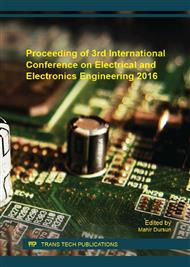[1]
F. Tamburini, E. Mari, A. Sponselli et al, Encoding many channels on the same frequency through radio vorticity: first experimental test, Trans. on New Journal of Physics, 14(2012) 1343-1346.
DOI: 10.1088/1367-2630/14/3/033001
Google Scholar
[2]
Yan Yan, Guodong Xie, Martin P. J. Lavery et al, High-capacity millimeter-wave communications with orbital angular momentum multiplexing, Nature Communications, 2014, 1-8.
Google Scholar
[3]
Y. S. Jiang, Y. T. He, and F. Li, Electromagnetic orbital angular momentum in remote sensing, Proc. of PIERS Proceedings. Moscow, Russia: IEEE Press, (2009).
Google Scholar
[4]
Tiezhu Yuan, Hongqiang Wang, Yuliang Qin et al, Electromagnetic vortex imaging using uniform concentric circular arrays, IEEE Antennas and Wireless Propagation Letters, (2015).
DOI: 10.1109/lawp.2015.2490169
Google Scholar
[5]
Yuqing Yuan, Zhaoyang Zhang, Ji Cang et al, Capacity analysis of UCA-based OAM multiplexing communication system, Proc. of Wireless Communications and Signal Processing. Nanjing, China: IEEE Press, (2015).
DOI: 10.1109/wcsp.2015.7341308
Google Scholar
[6]
B. Thide, H. Ten, J. Sjoholm et al, On the utilization of photon orbital angular momentum in the low-frequency radio domain, Phys. Rev. Lett., 99(2007) 1-5.
Google Scholar
[7]
Kwasi A. O., Kuang Yu-jun, Jerry J. K. et al, Mode combination in an ideal wireless OAM-MIMO multiplexing system, IEEE Wireless Communication Letters, (2015).
DOI: 10.1109/lwc.2015.2434375
Google Scholar
[8]
Kwasi A. O. and Kuang Yu-jun, Performance of an ideal wireless orbital angular momentum communication system using multiple-input multiple-output techniques, Proc. of Telecommunications and Multimedia. Heraklion, Greece: IEEE Press, (2014).
DOI: 10.1109/temu.2014.6917751
Google Scholar
[9]
Kwasi A. Opare, Yujun Kuang, Jerry J. Kponyo et al, The degrees of freedom in wireless line-of sight OAM multiplexing systems using a circular array of receiving antennas, Proc. of Advanced Computing and Communication Technologies. Haryana, India: IEEE Press, (2015).
DOI: 10.1109/acct.2015.52
Google Scholar
[10]
Yingjie Zhang, Wei Feng and Ning Ge, On the Restriction of utilizing orbital angular momentum in radio communications, Proc. of Communications and Networking. Guilin, China: IEEE Press, (2013).
DOI: 10.1109/chinacom.2013.6694604
Google Scholar
[11]
Dhananjay A G, Rohit U N and Arogyaswami P, Selecting an optimal set of transmit antennas for a low rank matrix channel, Proc. of Acoustics, Speech and Signal Processing. Istanbul, Turkey: IEEE Press, (2000).
DOI: 10.1109/icassp.2000.861082
Google Scholar
[12]
Cho Yong-soo, Jaekwon K, Yang Won-young et al, MIMO-OFDM wireless communication with MATLAB, Beijing: Electronic Industry Press, (2013).
Google Scholar
[13]
Zhang Xinying, Kung Sunyuan. Capacity analysis for parallel and sequential MIMO equalizers[J]. IEEE Trans. on Signal Processing, 2003, 51(11): 2989-3002.
DOI: 10.1109/tsp.2003.818151
Google Scholar
[14]
Hua Ling and Qin Li-xin. Fast antenna selection algorithm based on Sorenson similarity coefficient[J]. Computer Engineering, 2011, 37 (16): 108-110.
Google Scholar
[15]
Zhang Yan-yun, Zhu Yi-jun, Zhang Shui-lian et al. New zero-forcing precoding scheme in MIMO systems[J]. Journal of Information Engineering University, 2012, 37(1): 32-36.
Google Scholar
[16]
M. Oldoni, F. Spinello, E. Mari et al, Space-division demultiplexing in orbital-angular-momentum based MIMO radio systems, Trans. on Antennas and Propagation, vol. 63, pp.4582-4587, Oct. (2015).
DOI: 10.1109/tap.2015.2456953
Google Scholar


